Editorial: Tourism requires strict safety plan

STAR-ADVERTISER
Waikiki Beach crowded with tourists.
The community has waited with bated breath for word from Gov. David Ige on this development, above everything: when and how trans-Pacific tourism can slowly but surely ramp up again, while the persistent coronavirus pandemic is held at bay.
The governor has promised quite soon to announce plans for allowing travelers, upon their arrival, to safely circumvent the 14-day quarantine mandate, in place since March 26. Settling on a testing protocol for tourists is seen as the key to a quarantine waiver — and to the revival of Hawaii’s moribund economy.
The visitor industry is the most critical piece of the state’s revenue puzzle. According to the Hawaii Tourism Authority, it’s the largest single source of private capital, supporting 216,000 jobs.
What is essential is that Ige map out a clear plan, with a firm starting date, so that the myriad companies that depend on the tourist dollar have time to prepare for delivering the safest environment they can for workers and visitors alike. Among the stakeholders, the Chamber of Commerce of Hawaii is pressing the administration for clear directions and support to affected businesses.
Even in the best-case scenarios, spikes in positive tests for COVID-19 will be unavoidable. Hawaii is seeing them already, simply by gradually reopening the full range of activities, including neighbor-island travel for local residents.
That said, these initial steps have been essential in laying the groundwork. An important element has been the traveler’s questionnaire that all arriving passengers receive; at the start they were principally used to identify the quarantine site.
Don't miss out on what's happening!
Stay in touch with breaking news, as it happens, conveniently in your email inbox. It's FREE!
Once tourism reopens in earnest, these documents should enable officials to reach travelers in the event of exposure to COVID-19 infections. An effective contact-tracing system will keep outbreaks within bounds and help avert another industry shutdown.
But the critical, additional piece will be testing, and Ige has been watching the outcome of a program instituted in Alaska. For travelers showing proof of a negative test for the virus 72 hours prior to arrival, the 14-day quarantine will be waived.
Ige and the administration’s top leadership have been in discussion to secure providers capable of handling testing for travelers. This is wise, given past Hawaii levels of tourist traffic.
The tentative plans also have included offering the alternative of testing upon arrival at the airport in Hawaii, similar to what’s been done in Alaska. Lawmakers already propose setting aside some of the federal COVID-19 aid for airport testing, anticipating this option will be needed.
However, the HTA and tour companies must make clear to prospective visitors that securing a test in advance offers more security for their trip. Those who test at the airport must expect to be quarantined until results comes back — and they must know that a positive test means the quarantine will extend the full 14 days.
The screening system contemplated now is far from perfect. For example, the ACLU of Hawaii Foundation has aired concerns about the facial-recognition component abridging travelers’ rights.
And the thermal screening would catch only about one-third of infectious passengers, according to a brief by the University of Hawaii Economic Research Organization. But the addition of a viral test is expected to catch up to 90% of the infections, according to UHERO, and that should spell success — in tandem, of course, with routine mask-wearing, social distancing and hand-washing.
For the long term, Hawaii still must strive for a diversified economy: The pandemic has proven that much. But it’s an economic survival strategy that’s needed now. And tourism is key to survival.



